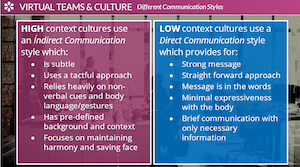All of us who are working remotely have set up home offices, joined several webinars and received dozens of emails on how to work virtually. By this point, you’re probably getting pretty good at it.
Now that many of us are settled into our work from home environments, it is a good time to take a deeper look at how different backgrounds, styles and cultures can shape our reactions to virtual work. By understanding these diverse preferences, you will be better able to interpret your colleagues and therefore make the most out of every remote interaction that you engage in.
Begin by asking yourself how you’d like others to interact with you. For example:
- Are you more accepting of an email if it begins with a personal salutation, or would you rather get right to the point?
- Do you prefer using a webcam or are you just as comfortable with the chat function?
- Are you comfortable jumping into a virtual conversation to share your ideas, or are you hesitant to speak because you don’t want to interrupt someone else?
The CultureWizard Culture Calculator Suite can help you get a closer look at your preferences, but the basic questions above are a great start. As you discover and define your preferences, you can be sure that others have preferences that are quite different from yours. Yet, each of you may hold these views strongly, as if they were “universal.”
Perhaps you have adapted to these different styles in face-to-face conversations, where you can read body language and benefit from other physical cues. But in a virtual setting, how do you recognize such different styles, adapt to each other’s preferences, and act inclusively—all while getting the job done effectively?
This is a complicated subject that’s discussed more thoroughly in the Virtual Teams course on the CultureWizard site, but for now, we’d like to focus on one key aspect of the Communication Dimension: Context.

Whether You’re a Direct or Indirect Communicator, Context Matters in Virtual Work
As you can see, there’s a dramatic difference in the way people use context in virtual communication. You can also see how remote work interactions may be easier for those who are low-context individuals, because their message is often direct and in the words, not their body language.
Furthermore, people who are low-context communicators aren’t as worried about offending someone by interrupting, which allows them to express their opinions and ideas with fewer constraints. This means Direct Communicators might dominate a virtual discussion while their high-context colleagues (Indirect Communicators) wait for a space in the conversation or are invited to speak.
In Virtual Meetings, Silence Can be Interpreted in Different Ways
Silence can hang very heavily over a virtual meeting. This is especially so for low-context communicators who are uncomfortable with silence. High-context communicators use silence as part of their interaction, such as to process their thoughts and show respect for the speaker.
In other words, it becomes obvious that virtual interactions between high- and low-context individuals can create some challenges and miscommunication. In order to maximize the value of remote conversations and make our virtual work from home experiences more productive, we need to recognize these styles and find ways to flex our own style to accommodate contributions from everyone.
Here are some suggestions to bridge various work styles when working remotely:
- Appreciate Silence and Encourage Hesitant Speakers During Virtual Meetings
Try to remember that silence and hesitancy can have many meanings. Sometimes it might mean your team member is formulating what they want to say. In other situations, it can mean they’re contemplating what others have said. In others, silence may signal disagreement and that the person doesn’t want the speaker to lose face or create conflict.
In any event, do not interpret silence as agreement or as disinterest. You need to wait for further information and clarification.
- Practice Active Listening—Whether Working Virtually or In Person
Active listening is the process of acknowledging the speaker and consciously attempting to fully comprehend the message. It means that you really listen to the speaker, suspend judgment, and focus on the facts to get to the meaning of the communication.
- Ask Open-Ended Questions to Inclusively Engage with Colleagues
Ask open-ended, clarifying questions such as:
- What do you think of this suggestion?
- Who do you think would work on this most effectively?
- What challenges does this project present for you/your team?
Such questions can elicit responses from quieter team members, drive discussion, and ensure that everyone’s voice is heard.
- Verify Understanding
The virtual nature of remote work can make it harder to understand one another. To ensure understanding, it’s useful to paraphrase and verify your interpretation of the message. For example, you could say,
- “I understood you to say, ….”
- “Let me rephrase what I think you said to be sure I got the meaning.”
- “Based on what you’re saying, we could….”
- Different Communication Styles Make Remote Work Challenging
Working remotely will not end with the cessation of the pandemic. In fact, we believe virtual teamwork to be one of the lingering benefits of “sheltering in place” because there are business reasons for doing it. Working remotely from home allows for work-life balance, talent flexibility, greater freedom across geographic boundaries, and a host of other benefits.
In our experience, gaining the skills that will make you more productive in the virtual work world will serve you well for years to come and give you greater work satisfaction.


